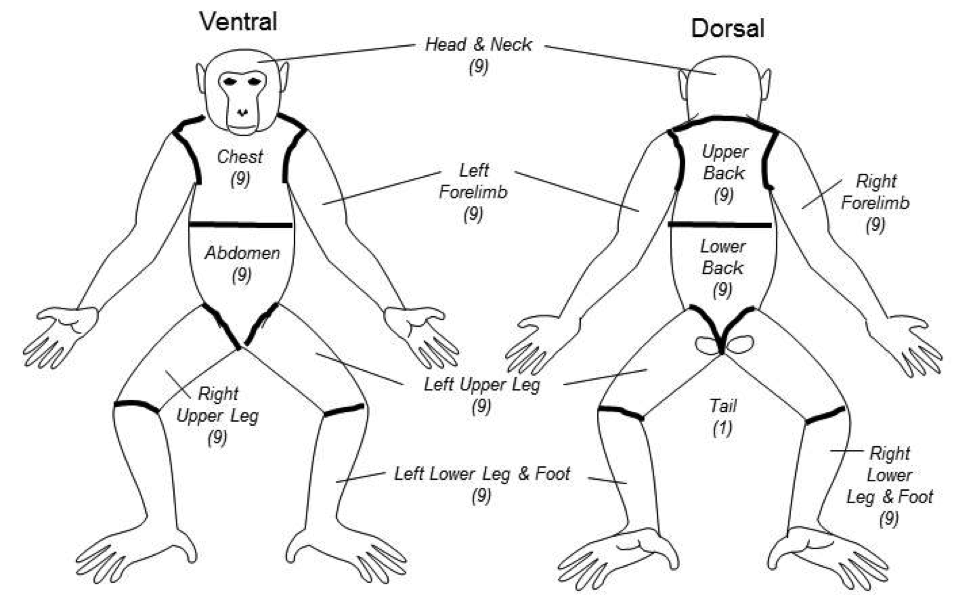BMC - Alopecia Scoring
Alopecia, or hair loss, is common among captive nonhuman primates. While the exact welfare implications of alopecia are not clear, its high prevalence is of concern to behavioral managers, veterinarians and regulatory agencies. Several factors have been implicated as contributing to alopecia including compromised immune function, dermatological pathologies, and environmental factors. However, these findings are often not replicated, highlighting the need to further examine alopecia. A critical first step towards cross-center comparisons is developing a common tool for evaluating alopecia. The BMC has developed an alopecia scoring system that is both straightforward to implement in large facilities and provides useful information.
The BMC scoring system starts by estimating the amount of the subject’s body surface affected by alopecia, using the “Rule of Nine’s”. This system is based on the Wallace Rule of Nine’s (e.g., Hettiaratchy and Papino, 2004), a tool developed by the medical community to estimate the percent of body surface affected by burns. This tool breaks the body into 11 “parts”, each of which is approximately 9% of the body (see below). The Rule of Nine’s is meant to help assess the total amount of the body affected by a particular issue (e.g., burns in humans or alopecia in monkeys). After the percent of the body affected by alopecia is calculated, it is then categorized into a 6 point scale (see below).
There are several assumptions that can assist with scoring. One assumption involves which body parts should be included in the analysis. For example, the chest and stomach of rhesus and other macaques often have very fine hair, and it can be difficult to determine whether or not the hair is actually missing, particularly from a photograph. Thus, we assume that these areas are ‘haired’, unless it is obvious that hair is missing (e.g. the observer is assessing alopecia on a sedated animal and can thus feel the hair). Areas clearly shaved (for medical procedures, etc.) are also assumed to be haired (since hair loss was the result of human intervention). Areas of regrowth (determined by the presence of shorter hair) are included as “haired”.
References
Hettiaratchy, S. and R. Papini. 2004. Initial management of a major burn: II-assessment and resuscitation. British Medical Journal 329:101-103.
Estimation of the “rule of nine’s” adapted for use with nonhuman primates

Behavioral Management Consortium Alopecia Scoring Scale
| Score | Area affected by alopecia |
| 0 | No alopecia |
| 1 | 1% - 10% |
| 2 | >10% - 25% |
| 3 | >25% - 50% |
| 4 | >50% - 75% |
| 5 | >75% - 100% |
Alopecia Publications
Bellanca RU, Lee GH, Vogel K, Ahrens J, Kroeker R, Thom JP, Worlein JM.
A simple alopecia scoring system for use in colony management of laboratory-housed primates.
J. Med. Primatol. 2014 Jun; 43(3): 153-61.
Coleman K, Lutz CK, Worlein JM, Gottlieb DH, Peterson E, Lee GH, Robertson ND, Rosenberg K, Menard MT, Novak MA.
The correlation between alopecia and temperament in rhesus macaques (Macaca mulatta) at four primate facilities.
Am. J. Primatol. 2017 Jan; 79(1): 1-10.
Kroeker R, Bellanca RU, Lee GH, Thom JP, Worlein JM.
Alopecia in three macaque species housed in a laboratory environment.
Am. J. Primatol. 2014 Apr; 76(4): 325-34.
Kroeker R, Lee GH, Bellanca RU, Thom JP, Worlein JM.
Prior facility affects alopecia in adulthood for rhesus macaques.
Am. J. Primatol. 2017 Jan; 79(1): 1-9.
Luchins KR, Baker KC, Gilbert MH, Blanchard JL, Liu DX, Myers L, Bohm RP.
Application
of the diagnostic evaluation for alopecia in traditional veterinary
species to laboratory rhesus macaques (Macaca mulatta).
J. Am. Assoc. Lab. Anim. Sci. 2011 Nov; 50(6): 926-38.
Lutz CK, Coleman K, Worlein J, Novak MA.
Hair loss and hair-pulling in rhesus macaques (Macaca mulatta).
J. Am. Assoc. Lab. Anim. Sci. 2013 Jul; 52(4): 454-7.
Lutz CK, Coleman K, Worlein JM, Kroeker R, Menard MT, Rosenberg K, Meyer JS, Novak MA.
Factors influencing alopecia and hair cortisol in rhesus macaques (Macaca mulatta).
J. Med. Primatol. 2016 Aug; 45(4): 180-8.
Lutz CK, Sharp RM.
Alopecia in Outdoor Group- and Corral-Housed Baboons (Papio hamadryas spp.).
J. Am. Assoc. Lab. Anim. Sci. 2015 Jul; 54(4): 384-8.
Novak MA, Hamel AF, Coleman K, Lutz CK, Worlein J, Menard M, Ryan A, Rosenberg K, Meyer JS.
Hair loss and hypothalamic-pituitary-adrenocortical axis activity in captive rhesus macaques (Macaca mulatta).
J. Am. Assoc. Lab. Anim. Sci. 2014 May; 53(3): 261-6.
Novak MA, Menard MT, El-Mallah SN, Rosenberg K, Lutz CK, Worlein J, Coleman K, Meyer JS.
Assessing significant (>30%) alopecia as a possible biomarker for stress in captive rhesus monkeys (Macaca mulatta).
Am. J. Primatol. 2017 Jan; 79(1): 1-8.
For more information regarding NPRC Behavioral Management resources, please contact support@nhprc.org.
